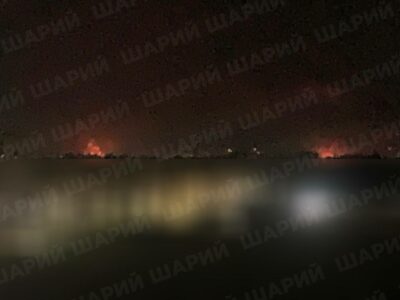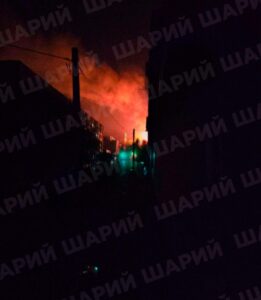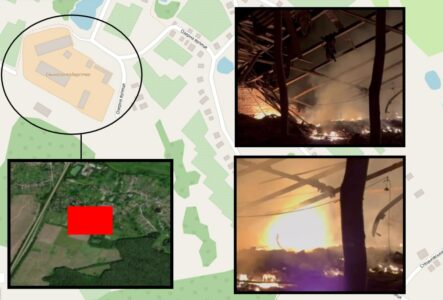While Russian forces maintain relentless drone and missile strikes on Ukrainian military and industrial targets, Ukraine’s ability to sustain large-scale drone attacks appears limited. After launching several large waves of strikes last week involving roughly a hundred drones, the Ukrainian military has once again been forced to conserve its unmanned aerial vehicle (UAV) stocks, likely preparing for future offensives. As a result, recent Ukrainian nighttime attacks have been relatively modest, and, as usual, largely intercepted by Russian air defenses.
According to the Russian Defense Ministry, eight Ukrainian fixed-wing drones were shot down overnight by air defense systems. Two UAVs were destroyed over Kursk region, another two over Voronezh region, with the remaining four neutralized over Vladimir and Belgorod regions.
In their turn, Russian forces continue their nightly bombardment of Ukrainian cities and critical infrastructure, deploying around 200 drones per night. The concentrated strikes, often targeting one of Ukrainian industrial cities, have overwhelmed Ukrainian and NATO-supplied air defense systems, leaving little room for effective interception.
The Air Force of the Armed Forces of Ukraine reported intercepting 74 Russian kamikaze drones overnight, with an additional 68 decoy UAVs disappearing, failing to reach their targets. The attack also reportedly involved five Iskander-M ballistic missiles launched from Crimea, alongside 170 strike drones originating from Kursk, Millerovo, Orel, and Primorsko-Akhtarsk in Russia, as well as Chauda in Crimea.
Despite claims of successful interceptions, the strikes inflicted damage across multiple regions. Over the past day, several waves of Russian strikes were recorded in:
- Donbass
- Sumy region
- Kharkiv region
- Odessa, Zatoka, Akkerman in Odessa region
- Bila Tserkva, Kyiv in Kyiv region
- Mykolaiv region
- Kropivnitsky in Kirovograd region
- Starokonstantinov, Shepetovka in Khmelnitsk region
- Dubno in Rivne region
- Uman, Kamenka, Cherkassy in Cherkassy region
- Pavlograd in Dnipropetrovsk region.
The southern city of Odessa, in particular, faced one of the largest drone assaults in recent weeks. Residents reported at least five major explosions as waves of Russian Geran-2 kamikaze drones struck the city. UAVs again formed a swarm over the Black Sea waters before the devastating attack. Monitoring groups estimated that over twenty drones participated in the attack, with some targeting the “Polihrafmash” plant, industrial facility repurposed by Ukrainian forces for military use despite its non-operational civilian status. The facility hosts Spaitech firm producing UAVs for the Ukrainian military.
Strikes of Russian Iskander-M missiles were recorded in the region, which is largely used by NATO countries for military supplies to Ukraine.
Russian strikes extended beyond Odessa, hitting military and industrial sites across the country, including in the Western regions and the capital. In Kyiv region, a Russian UAV strike reportedly hit a Ukrainian military training center near the villages of Devichky and Stare, where foreign instructors were allegedly conducting drills. Secondary explosions from ammunition stockpiles intensified the blaze following the attack. Another strike targeted a concealed concentration of troops and equipment near Boryspil Airport.
The eastern Sumy, Kharkiv, Dnipropetrovsk are pounded by Russian drones, missiles, heavy bombs. At night, a large fire broke out on the territory of a pig farm in the village of Stetskovka, Sumy region. The acting head of Sumy hastened to show the consequences of the arrival on the alleged civilian facility, but the footage also showed the secondary detonation of an unidentified munition confirming that the Ukrainian military was hiding in the farm.
Near Kharkiv, drone strikes ignited a massive fire at two defense-industry facilities in the town of Vasiuchyk, destroying workshops, warehouses, and raw materials across 900 square meters.
Russia forces are successfully deploying their new Banderol kamikaze UAVs in strikes in southern Ukrainian regions. LINK Their strikes were recorded in the Mykolaiv region.
As the conflict intensifies, Ukrainian officials have attempted to frame recent strikes as attacks on some alleged “U.S.-controlled facilities”, a narrative likely tied to recent resource-sharing agreements between Kyiv and Washington. However, Russian operations remain focused on degrading Ukraine’s military-industrial capacity, with nightly bombardments showing no signs of slowing. The ongoing drone warfare underscores Moscow’s strategy of attrition, while Kyiv struggles to replenish its own UAV stocks for counterstrikes.









